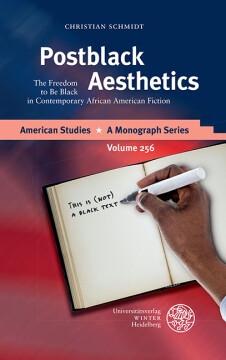
BUCH
Postblack Aesthetics
The Freedom to Be Black in Contemporary African American Fiction
American Studies – A Monograph Series, Bd. 256
2017
Zusätzliche Informationen
Bibliografische Daten
Abstract
‘Postblack Aesthetics’ investigates the changing contours of contemporary African American fiction. It argues that the novels and short stories by Paul Beatty, Trey Ellis, Percival Everett, Charles Johnson (but also white author Adam Mansbach) continue the African American literary tradition even if they do so in satirical, parodic, and highly self-reflexive ways. Through rigorous close readings, the study analyzes form and themes of this fiction as ‘postblack’ (Thelma Golden). Postblack art engages in complex redefinitions of blackness that transcend confining notions of mimetic literary representation while being aware of continuing social discrimination. In their respective attempts to re-write black fiction, these texts revolve around the central topos of freedom – a freedom from, first and foremost, confining notions of ‘literary’ blackness. Among the crucial questions discussed are: What is a (post)black text? What is a black author? How does blackness figure in contemporary literature?
Inhaltsverzeichnis
| Zwischenüberschrift | Seite | Aktion | Preis |
|---|---|---|---|
| Cover | Cover | ||
| Titel | III | ||
| Imprint | IV | ||
| Contents | V | ||
| Acknowledgments | VII | ||
| 1 Introduction: Race and Postblack Literature | 1 | ||
| 2 Postblack Aesthetics | 21 | ||
| 2.1 Postblack Art, Black Culture, and Transdifference | 28 | ||
| 2.2 The Post-Soul Generation | 35 | ||
| 2.3 Scripts of Blackness and Thin Blackness | 43 | ||
| 2.4 The Trope of Freedom | 51 | ||
| 2.5 Cosmopolitan Ethics | 58 | ||
| 2.6 Texts of the Postblack Aesthetics | 66 | ||
| 3 Re-Forming Black Literature: Charles Johnson’s "Oxherding Tale" and Short Fiction | 77 | ||
| 3.1 “China”—Taking the Imaginative Leap into the Liberation of Perception | 85 | ||
| 3.2 Freeing the Form in "Oxherding Tale" | 91 | ||
| 3.3 “Put simply, your task is impossible”: The Responsibility of an “Executive Decision | 107 | ||
| 4 Re-Writing the Text of Blackness: “Mimetic hacks” in Trey Ellis’s "Platitudes" and Percival Everett’s "Erasure" | 125 | ||
| 4.1 Cultural Mulattoes and the Script of Authentic Blackness | 130 | ||
| 4.2 Intertextual Love and the “common vorld” of Platitudes | 138 | ||
| 4.3 No Love Lost for the “real thing” in "Erasure" | 149 | ||
| 5 Political Narratives of (Thin) Blackness: Paul Beatty’s "The White Boy Shuffle" and Charles Johnson’s "Dreamer" | 171 | ||
| 5.1 Thin Blackness and Postblackness | 173 | ||
| 5.2 Fighting “the eternal war for civility”: "The White Boy Shuffle" | 178 | ||
| 5.3 “If we stop, we’ll fall and be trampled”: "Dreamer" and the Imperative to Keep Moving | 200 | ||
| 6 Beyond the Invisible Walls of Blackness: Cosmopolitan Themes in Adam Mansbach’s "Angry Black White Boy" and Paul Beatty’s "Slumberland" | 223 | ||
| 6.1 Cosmopolitan Conviviality | 227 | ||
| 6.2 The White Race Traitor in "Angry Black White Boy" | 234 | ||
| 6.3 Declaring Blackness Passé in "Slumberland" | 249 | ||
| 7 Epilogue: Is Postblackness the End of African American Literature | 269 | ||
| 8 Works Cited | 287 | ||
| Backcover | Backcover |


 Publishing Platform by CloudPublish
Publishing Platform by CloudPublish